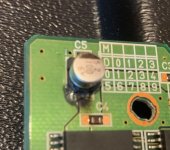yep, glad you got it fixed
for newbies, this is a good example of how, even if you are
not an electronics tech, to sometimes get your device fixed,
and that is to first look closely for a physical clue. Sometimes
irregularities in a solder joint like tiny rocklike corrosion,
an odd color like the blue-green of turquoise but a dull sheen
fracturing of the solder no shine no smoothness
also look at the circuit board itself.. stress can cause a crack
or a hidden crack in a trace on the board that only is visible
when flexed or seen when shining a light at angles
sometimes re-heating the joints can fix the solder, sometimes
you need to wick some of the old solder away and replace it with
fresh solder (this is because there is flux inside the new solder
which helps attach the solder to the copper/metal of a leg
or trace) Board and trace cracks you first clean the copper surface
of the trace and lay a solid piece of small copper wire across it
and solder that on (like a little bridge) as well as strengthening the
underlying board with something physical
if you need to replace a soldered in part, use a wick to pull all the
old solder off the legs and make certain you have a replacement
jack with the same exact internal switching setup.. these things
have many variations and you can look up their individual part
schematic based on part number
be aware of neighboring discreet components, and be careful
of overheating something nearby


